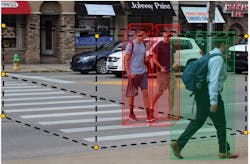Oyla looks to drive the fusion of video, AI and 3D sensing technologies
One technology that has gained traction across the security industry in recent years is Lidar, which uses a stream of lasers to create a 3D image of the surrounding area. It is one of the technologies that makes autonomous vehicles possible and has also been touted as a potential game-changer for perimeter security applications.
In conjunction with the rise of Lidar, video surveillance has also seen its fair share of innovation in recent years, predominantly around intelligent video analytics with the advent of artificial intelligence (AI) solutions powered by a new and improved wave of machine learning algorithms. Unlike the video analytics that were highly touted and then quickly fizzled a decade ago, many believe AI has real staying power and will eventually revolutionize the industry.
What if you could combine these two technologies to create a solution that provides the best of both worlds? That is exactly what Oyla intends to do with its new 3D-aware surveillance camera that integrates Lidar with video and thus creates an image that can greatly improve the accuracy of video analytics.
According to Oyla CEO Srinath Kalluri, who has an extensive background in photonics having previously served as senior director and head of R&D at Intel’s Silicon Photonic Products Division, they saw an opportunity to bring over technology from this space to the realm of video surveillance to make better cameras.
“One of the things we noticed in this space was that it was hungry for our solution,” Kalluri says. “Based on the trajectory of the technologies in this space, we saw the convergence of AI and our technology – our background in communications theory, lasers, optics, and cameras – and knew we could come up with a solution that would really enhance the intelligence that you can get at the point video surveillance needs to happen, right at the point of the event itself.”
Having been involved as a supplier in the development of what would eventually become Apple’s Face ID technology, which essentially integrates 3D sensing and video, Kalluri says he realized there were more applications for this that were not being adequately addressed.
“On an iPhone, real estate is really, really valuable but the fact that in addition to a camera they felt they needed to put something else into that really tight real estate… made an impression (on me) and clearly it was a technology that had benefits for those kinds of tasks,” he adds. “On the other end, we saw a lot of stuff happening in the autonomous driving space where people were trying to address this safety critical application and the need for cars to navigate in real world environments and cameras were not enough. That is why you see the KFC fried chicken bucket on a lot of these cars as they are trying to provide more information to the computer to make smarter, real-time choices.”
In looking at these two opposite ends of the spectrum, Kalluri says there seemed to be an opportunity for Lidar in the broader mid-market, which included security and the ability to improve the accuracy of video analytics. And although Lidar provides a user with a lot of information about a scene, oftentimes an image from the visible spectrum is needed to help properly identify objects, which according to Kalluri, made bringing the two domains together in a single solution a no-brainer.
“There are a lot of reasons why video has benefits but also has challenges and there are a lot of reasons why Lidar has benefits but also has challenges. When you put these two technologies together and do it in such as way that you are actually fusing the data – it is not just that we have Lidar and we a camera and they operate kind of independently – and they operate cooperatively along with our AI to provide more intelligence,” he says.
From a cost perspective, Kalluri says they can provide both of these solutions in a single form factor for nearly the cost of a typical outdoor surveillance camera. Initially, Kalluri says they plan to focus their efforts on getting the camera into perimeter intrusion and Smart Cities applications as they will be providing an end-to-end-type of solution, however; the company is building its technology on an open platform and they have plans to begin integrating with VMS software providers starting next year. In terms of their go-to-market strategy, Kalluri says they plan, at least in the beginning, to partner with vertical market OEMs to provide a complementary product to their existing solutions.
“After that, more broadly, we will work with integrators and the channel and both our cost structure and architecture are amendable to that,” he adds. “We do realize that there is some level of integration with VMS that is required to make that channel path more amendable, but it is kind of a staged process.”
The Oyla camera is currently being piloted by several customers and Kalluri says they plan to do a full product release in Q3 of next year.
Joel Griffin is the Editor-in-Chief of SecurityInfoWatch.com and a veteran security journalist. You can reach him at [email protected].About the Author
Joel Griffin
Editor-in-Chief, SecurityInfoWatch.com
Joel Griffin is the Editor-in-Chief of SecurityInfoWatch.com, a business-to-business news website published by Endeavor Business Media that covers all aspects of the physical security industry. Joel has covered the security industry since May 2008 when he first joined the site as assistant editor. Prior to SecurityInfoWatch, Joel worked as a staff reporter for two years at the Newton Citizen, a daily newspaper located in the suburban Atlanta city of Covington, Ga.

